

British Shorthair need love and attention if they are to become the loyal, loving companions they can be the more attention and affection you give them, the more they will repay you in kind. When they get over their initial reserve, however, they become extremely faithful companions. They are quiet, even-tempered, and undemanding with a bit of typical British reticence, particularly when they’re first introduced. British Shorthairs like to keep a low profile they are affectionate but not clingy, playful but not overactive. Some say the British Shorthair is the perfect household companion if you like a breed that’s undemanding, not always underfoot or in your face.
#BROWN TABBY CAT KITTEN SERIES#
The order of dominance in this allelic series is B dominant to b, and b dominant to b l (B > b > b l).If you’re looking for a cat that will loot your refrigerator and swing dizzily from your chandeliers, then the British Shorthair is not for you. The b allele produces the brown or chocolate phenotype and the b l allele produces a light brown or cinnamon phenotype. The wild-type B allele produces normal, black coloration (full production of eumelanin). The two variants form an allelic series that lead to these shades of brown. A lighter brown variant commonly called cinnamon/red is caused by a nonsense mutation (c.298T>C) that also results in an truncated protein. The darker shade of brown coat color referred to as chocolate/chestnut results from an intronic mutation that causes a splice variant (c.1261+5G>A) which results in a truncated protein. Research by Lyons Feline Genetics Laboratory at University of California, Davis identified two mutations in this gene that cause different variations of brown coat colors in cats. The tyrosinase-related protein-1 ( TYRP1) gene affects the amount of black pigment (eumelanin) produced, and mutations in this gene are known to cause brown coat color phenotypes in many species of mammal.

Note: Overall appearance of the cat's coat also depends on expression of and complex interactions with other genes.Ĭinnamon (center) and chocolate (left and right) British Shorthair kittens Cats with b l/b l genotype will be cinnamon and will transmit this cinnamon variant to all of their offspring.Matings between two carriers of cinnamon are predicted to produce 25% cinnamon kittens. They will transmit this cinnamon variant to 50% of their offspring. Cats with b/b l genotype will be chocolate and are carriers of cinnamon.Cats with b/b genotype will be chocolate and will transmit this chocolate variant to all of their offspring.Cats with B/b l genotype will be full-colored and are carriers of cinnamon.Matings between two carriers of chocolate are predicted to produce 25% chocolate kittens. They will transmit this chocolate variant to 50% of their offspring. Cats with B/b genotype will be full-colored and are carriers of chocolate.They cannot produce chocolate or cinnamon offspring and cannot transmit these chocolate or cinnamon variants to any of their offspring. Cats with B/B genotype will be full-colored and will not display chocolate or cinnamon coloration.Mode of Inheritance: Autosomal recessive (order of dominance is B > b > b l)Īlleles: B = Wild-type black, b= Brown (chocolate), b l = Light brown (cinnamon)īreeds appropriate for testing: Many breeds Phenotype: Cats with brown gene variants have reduced eumelanin (black pigment) and appear brownish in color. British Shorthair with cinnamon coat color (left) Havana Brown with chocolate coat color (right)


 0 kommentar(er)
0 kommentar(er)
